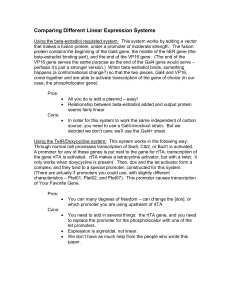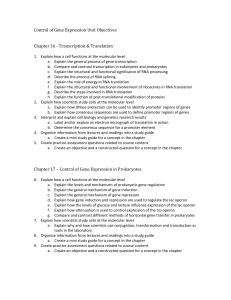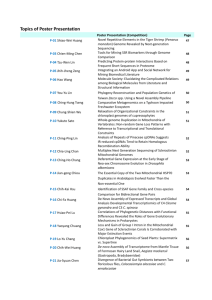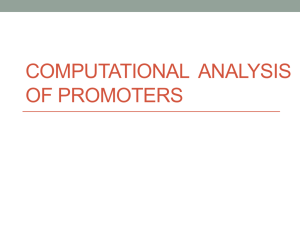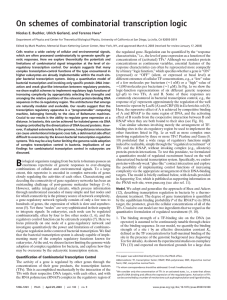Additional file 1
advertisement
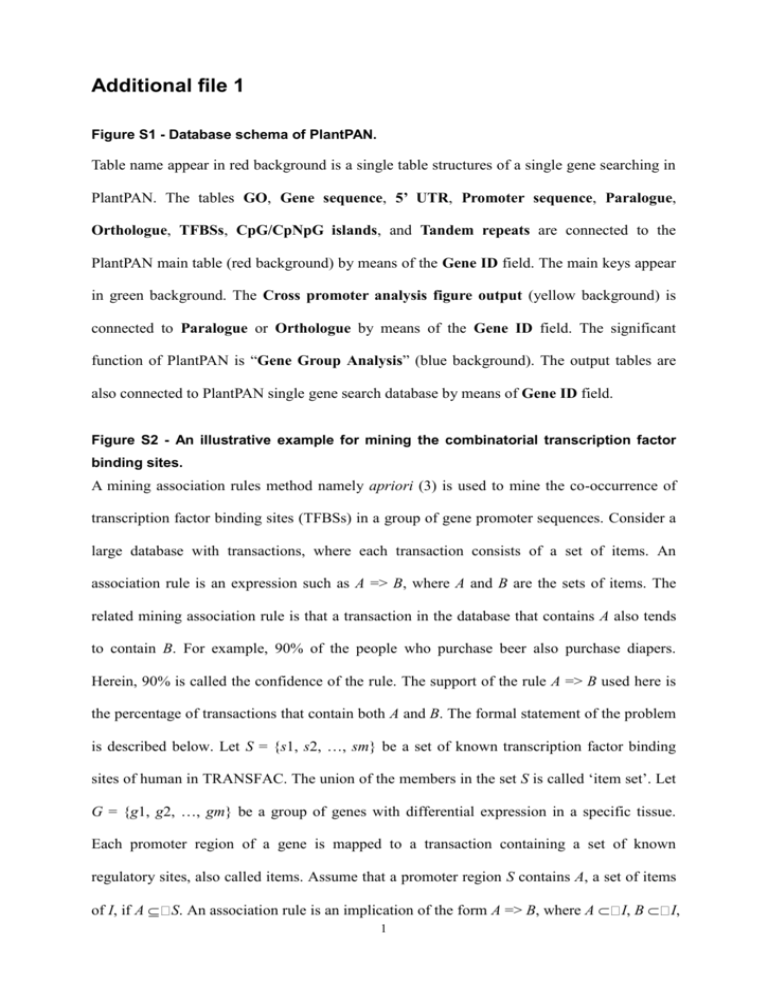
Additional file 1
Figure S1 - Database schema of PlantPAN.
Table name appear in red background is a single table structures of a single gene searching in
PlantPAN. The tables GO, Gene sequence, 5’ UTR, Promoter sequence, Paralogue,
Orthologue, TFBSs, CpG/CpNpG islands, and Tandem repeats are connected to the
PlantPAN main table (red background) by means of the Gene ID field. The main keys appear
in green background. The Cross promoter analysis figure output (yellow background) is
connected to Paralogue or Orthologue by means of the Gene ID field. The significant
function of PlantPAN is “Gene Group Analysis” (blue background). The output tables are
also connected to PlantPAN single gene search database by means of Gene ID field.
Figure S2 - An illustrative example for mining the combinatorial transcription factor
binding sites.
A mining association rules method namely apriori (3) is used to mine the co-occurrence of
transcription factor binding sites (TFBSs) in a group of gene promoter sequences. Consider a
large database with transactions, where each transaction consists of a set of items. An
association rule is an expression such as A => B, where A and B are the sets of items. The
related mining association rule is that a transaction in the database that contains A also tends
to contain B. For example, 90% of the people who purchase beer also purchase diapers.
Herein, 90% is called the confidence of the rule. The support of the rule A => B used here is
the percentage of transactions that contain both A and B. The formal statement of the problem
is described below. Let S = {s1, s2, …, sm} be a set of known transcription factor binding
sites of human in TRANSFAC. The union of the members in the set S is called ‘item set’. Let
G = {g1, g2, …, gm} be a group of genes with differential expression in a specific tissue.
Each promoter region of a gene is mapped to a transaction containing a set of known
regulatory sites, also called items. Assume that a promoter region S contains A, a set of items
of I, if A S. An association rule is an implication of the form A => B, where A I, B I,
1
and A B = . The rule A => B holds in the set of promoter regions D with confidence conf
if c% of transactions in D contains both A and B. The rule A => B has support sup in the
repetitive sequence set D if s% of promoter regions in D contain A B. The association
rules, the so-called co-occurrence of TFBSs, are generated if the rule has a higher support and
confidence than specified by the user.
Figure S3 - Results of case study II in “Gene group analysis”.
(A) Reference case taken from Wellmer et al., 2006 [44]. The genes used in the case study are
marked in yellow boxes. (B) AP1 displayed co-occurrences in TFL1 (At5g03840.1), LFY
(At5g61850.1), FUL (At5g60910.1), AGL24 (At4g24540.1) and PI (At5g20240.1). (C) AP1
and C1-motif (C1MOTIFZMBZ2) represented combinatorial co-occurrences in TFL1
(At5g03840.1), LFY (At5g61850.1), FUL (At5g60910.1), AGL24 (At4g24540.1) and PI
(At5g20240.1).
Figure S4 - Identification of transcription factor binding sites in AT1G67090.1.
Figure S5 - Identification of tandem repeat regions in upstream sequence of AT4G26600.1.
Figure S6 - Identification of CpG/CpNpG islands in AT3G46580.1.
Table S1 - Comparison of PlantPAN with other plant promoter analysis systems.
2
Figure S1 - Database schema of PlantPAN.
3
Figure S2 - An illustrative example for mining the combinatorial transcription factor
binding sites.
4
Figure S3 - Results of case study II in “Gene group analysis”.
5
Figure S4 - Identification of transcription factor binding sites in AT1G67090.1.
6
Figure S5 - Identification of tandem repeat regions in upstream sequence of AT4G26600.1.
7
Figure S6 - Identification of CpG/CpNpG islands in AT3G46580.1.
8
Table S1 - Comparison of PlantPAN with other plant promoter analysis systems.
Comparing items
AGRIS
Davuluri et al.,
2005
AthaMap
Steffens et al.,
2005
PLACE
Higo et al.,
1999
PlantCARE
Lescot et al,.
2002
Yes
Yes
Yes
Yes
CpG/CpNpG islands
-
-
-
-
Tandem repeats
-
-
-
-
-
-
Yes
-
Yes
-
Yes
-
-
Yes
(Aprior, distance
constraint)
-
-
Yes
Yes
Yes
Arabidopsis
Arabidopsis
plant TFs
plant TFs
plant TFs.
(Arabidopsis, rice,
and maize)
Reference
Transcription factor binding
sites
Cross-species comparison
of homologous gene
promoter sequences
Combinatorial
co-occurrence of
transcription factor binding
sites
On-line analysis for
regulatory features
Species supported
9
PlantPAN
Yes
(TRANSFAC,
PLACE, MATCH)
Yes
(CpGProD)
Yes
(Tandem Repeat
Finder)

